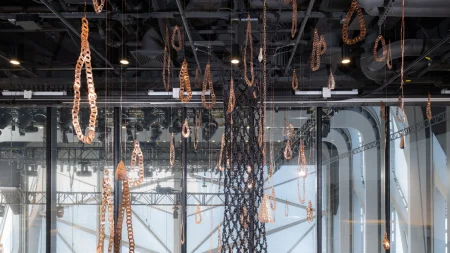
Photo Jason Mandella/Courtesy the artist and James Fuentes
Artist ektor garcia’s piece la llorona is installed at the Shed now that Frieze has opened its doors, but when garcia got on the phone with ARTnews last Thursday, all he had ready was a suitcase full of materials and a few ideas. While the prospect of creating a work in five days might provoke panic in another artist, garcia was feeling calm and upbeat about what was to come.
“I have plenty of ideas but I don’t like to plan anything,” said garcia in a phone call shortly after landing at Newark Liberty International Airport. His solo show at James Fuentes, titled “esfuerzo,” had closed at the end of April, and he was looking forward to getting back to work.
For this installation, part of the work was to involve the disassembling of past works. garcia was returning to New York from Chicago, where he had gone to pick up some works—ceramic tears that were glazed in a shiny metallic paint, others left in raw earth tones of stone white and terracotta—that had been on view at Prairie gallery in 2020. But main component of the piece is made from yet another work, recently shown at Rebecca Camacho Presents in San Francisco, he was repurposing: a 15–foot tapestry he had made by adjoining copper links. Since these pieces hadn’t sold, he would disassemble what he could to fashion la llorona.
Was it painful to undo all that work? “What is painful,” garcia replied, “is when they get taken from me and get sold, when after they’ve been ripped out of my body in the studio, freshly birthed, they go straight to galleries or institutions, which are asking for them before they’re even made.”
Despite the intensity of what he’s describing, garcia doesn’t come off as bitter. He’s happy with the life he’s been able to make for himself (“I’m free, I pay my bills and I like to eat well,” he said) and is settled with the knowledge that parting with his works comes with that.
Dissembling and remixing work, getting more time to keep engaging with a previous piece and the materials it was derived from, is a joyful opportunity that comes only when works don’t sell.
“That’s when the magic happens,” he added.

Photo Jason Mandella/Courtesy the artist and James Fuentes
garcia sees the materials he uses as alive, be it copper wire, leather, or clay. Part of that aliveness is the way those materials change over time, whether they bleach from exposure to the sun or develop a patina as they travel. “It’s the first time these works have left Chicago—they were made there,” he says of the clay tears that he has now shepherded to New York.
The tears in this new work refer directly to the Mexican folk tale of La Llorona, in which a wailing ghost can be heard crying near bodies of water over the children she drowned in a river. The story pre-dates colonialism but also found new meanings in the colonial age, as the myth shifted from a story of famine, in which she killed her children as an act of mercy, to one that encapsulated the violence that occurred between Indigenous women and Spanish conquistadores.
“I feel very effected by colonialism,” said garcia. “They say slavery was abolished but I don’t believe it.”
Meditating on this bed-time figure who is often trotted out to frighten children into good behavior, garcia has found an aspect of La Llorona that speaks to a positive expression of resistance, indigeneity, and femininity. The tears also call to mind the Yod symbol, the tenth letter of the Hebrew alphabet and the smallest one. The apostrophe-like symbol is the first one used when spelling a sacred name for God. In the tarot, the Yod often appears under the guise of lighting strikes, leaves, or water droplets, and signals the presence of divinity.
In his art, garcia aims to channel, rather than control, that sense of divinity as a way to tap into the mysterious and automatic that undergirds so much of human experience.
“I feel like the work is a book that has been written already and is being read through me,” he said.
Georgia O’Keeffe Made These Works After Going Blind
At Frieze, Dastan Gallery Presents an Intergenerational Grouping of Female Iranian Artists Spanning 100 Years

RobbReport
Pocket Watches From Patek Philippe, Zenith, and More Star in a New N.Y.C. Exhibition

WWD
Waxon, Sous La Face Prep Launch of Co-branded Beauty Destinations

BGR
Netflix might kill its cheapest Basic plan, and I don’t know why it exists to begin with

Sportico
ESPN Extends Reality in New Studio Built With ‘Mandalorian’ Tech

SPY

